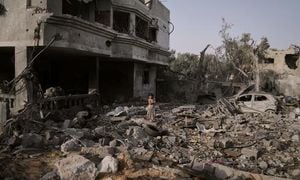Alex Parkinson’s Last Breath recreates a remarkable real-life event experienced by a team of saturation divers—Chris Lemons (Finn Cole), Dave Yuasa (Simu Liu), and Duncan Allcock (Woody Harrelson)—while working underwater during a violent storm in the North Sea in 2012. Cut off from their support ship, the divers must race against time to save one of their own from certain peril.
Adapting his acclaimed 2019 documentary, Last Breath, Parkinson brought on production designer Grant Montgomery, who had earned nominations for BAFTA awards on shows like Peaky Blinders. Montgomery's goal was to accurately replicate the intense and technical world of saturation divers, which was no small feat.
Reflecting on his process, Montgomery admitted, "From the script, I became aware of just how technical the story was." He considered the challenge of building everything on stages rather than on location since much of the action takes place underwater. At one point, he had considered building 1/10th scale models but opted for full-scale construction to provide the most authentic experience.
To craft the ship components and saturation chambers authentically, Montgomery and his team visited the original ship, The Topaz, which was docked in Aberdeen. "I was quite surprised at how big it was," he noted, emphasizing the monumental scale they were working with. This realization led to significant decisions, such as designing a special gimbal setup to make sure the bridge would pivot correctly, and how they ensured safety during filming.
All designs began with basic white-card models to visualize the scenes. Montgomery explained, "We built the saturation chamber as white card models so we could plan out the camera movement with our DP, Nick [Remy Matthews]." He ensured structural engineers verified the designs to create safe and practical spaces for actors to engage within the claustrophobic conditions the divers faced.
The chamber itself had to replicate real-world conditions, presenting extreme challenges. "The saturation chambers...were quite extraordinary. We kept the dimensions exactly the same as the real ones, which was a bit scary for everyone because they were so claustrophobic," said Montgomery. His approach included treating the chambers as tunnels, allowing for more flexibility during filming to alleviate claustrophobic feelings for the cast.
To heighten the dramatic effect and immerse viewers, Montgomery adjusted certain aspects of the design. The emotional weight of the film is palpable, as he noted, "When you read the script, it felt like you were in outer space...I pushed things just a little with the idea." By making minor modifications to aspects such as the main structure of the divers' bell, he created settings reminiscent of otherworldly locations, enhancing the overall dramatic experience.
Filming underwater involved innovative setups, such as shooting scenes at a large outdoor tank located in Malta. Montgomery described this as "quite the enterprise," which required creativity to work around practical challenges. Because the saline environment could ruin equipment, the production team had to constantly monitor their materials, ensuring they were safe for the divers to work within.
Reflecting on the overall message of the film, Montgomery passionately stated, "Never give up. When I read the script, I felt the underlying message is...the human spirit can—and does—surmount incredible odds." This theme resonates throughout the film, promising to leave audiences with hope and encouragement.
With Montgomery’s inspiring designs and Parkinson’s direction, Last Breath not only tells the story of survival against incredible adversity but also pays homage to the indomitable spirit of those who face life-threatening challenges. Audiences are bound to emerge inspired after witnessing these events come to life on the big screen, marked by impressive visual storytelling and human resilience.



